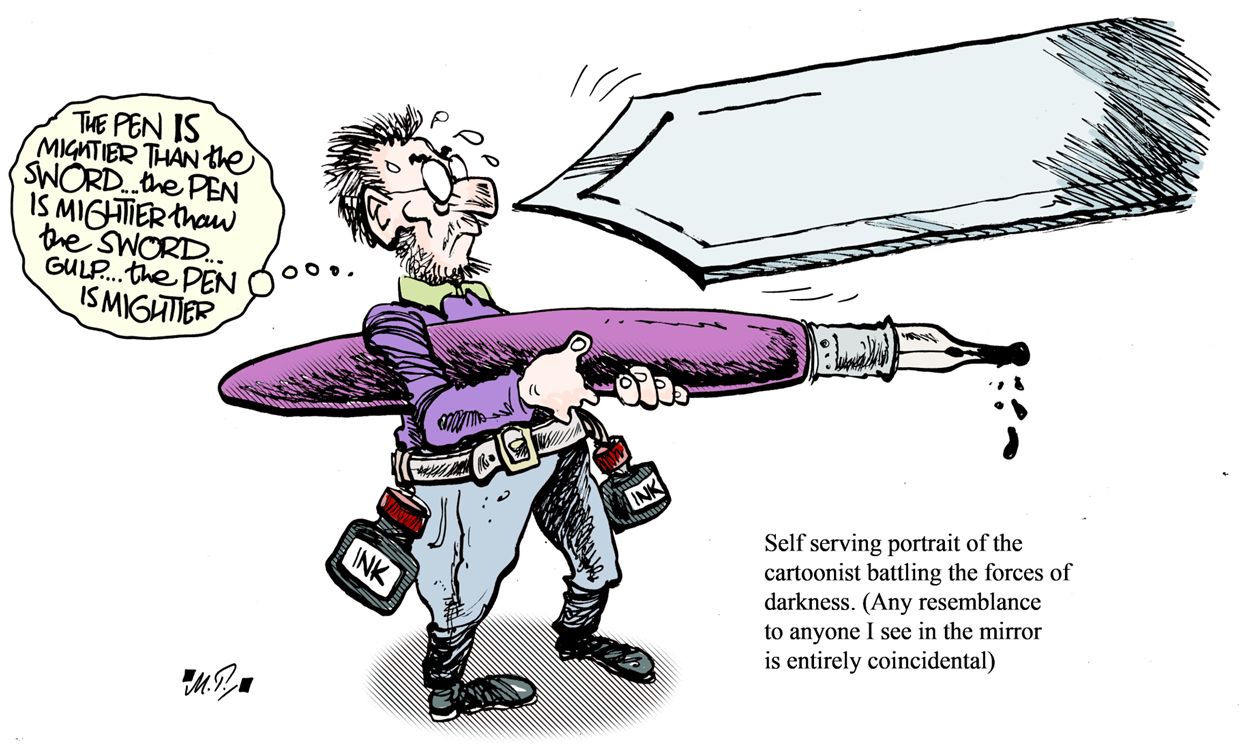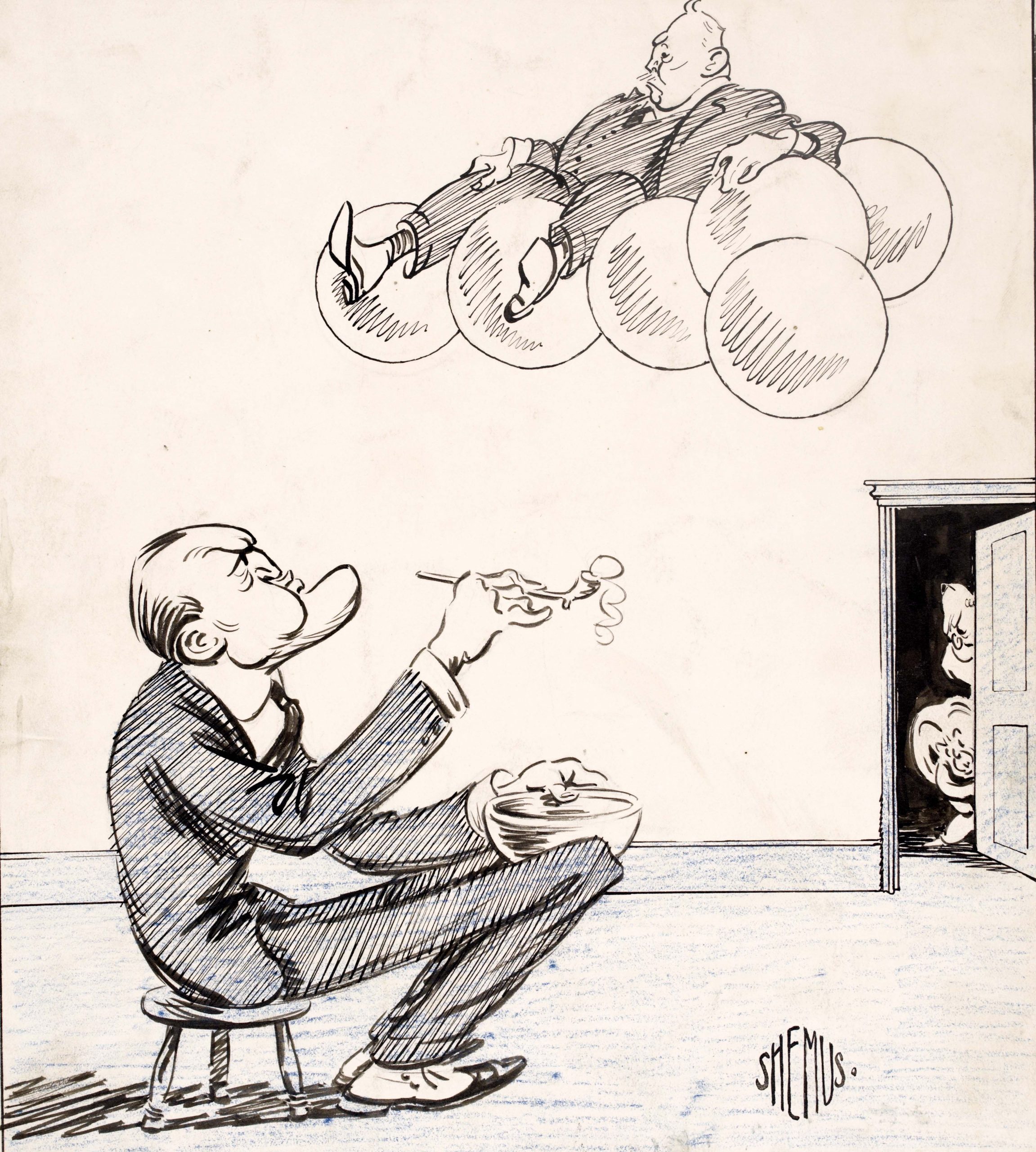The cartoonist as outsider: the case of Martyn Turner
Published in Issue 4 (July/August 2020), News, Volume 28BY FELIX M. LARKIN
 Martyn Turner, the Irish Times cartoonist since the 1970s, recently announced in the ‘Irishman’s Diary’ column in that newspaper that he had become an Irish citizen. Congratulations to him on that, but let’s hope it doesn’t diminish the acuity with which he comments in his cartoons on our follies and foibles.
Martyn Turner, the Irish Times cartoonist since the 1970s, recently announced in the ‘Irishman’s Diary’ column in that newspaper that he had become an Irish citizen. Congratulations to him on that, but let’s hope it doesn’t diminish the acuity with which he comments in his cartoons on our follies and foibles.
I say this because many of the best cartoonists in Ireland and Britain in the twentieth century have been outsiders in the society in which they operated. Their outsider status provided a degree of detachment that facilitated the pursuit of their quirky craft.
In the early years of independent Ireland, the two cartoonists regularly published in morning daily newspapers here were, like Martyn Turner, English. One of them, Ernest Forbes (‘Shemus’), was a Yorkshireman whose work appeared in the Freeman’s Journal during the War of Independence and Civil War. His hard-hitting cartoons reflected the editorial policy of the Freeman at that time. Up to the Anglo-Irish Treaty of 1921, their main target was the increasingly brutal nature of British rule in Ireland, while afterwards they attacked the new government of Northern Ireland and the die-hard republicans challenging the writ of the Free State authorities.
The other, Victor Brown (‘Bee’), contributed cartoons to the Irish Press in its early years, 1931–3. The Press being the organ of the Fianna Fáil party, his cartoons were necessarily highly partisan.
Two of the most prominent cartoonists in Britain in the early twentieth century, Percy Fearon (‘Poy’) and Will Dyson, were likewise outsiders. Fearon, born in China, had been raised in New York, and the brash tone of his cartoons reflected his American roots. He joined the Evening News in London in 1913 and remained there for the next 25 years. His work also appeared in the Evening News’s sister newspaper, the Daily Mail. His most notable cartoon creations were the ineffectual bureaucrats ‘Dilly and Dally’. Dyson, an Australian who came to London in 1910 and found a congenial berth as the cartoonist on the radical Daily Herald, was both brash and biting in images attacking capitalism and the political system that supported it. His cartoon ‘Curious! I seem to hear a child weeping’, published in May 1919, is famous for foretelling that the harsh terms of the Treaty of Versailles would lead to another world war.
David Low, the greatest cartoonist of the interwar years in Britain, was another Antipodean. Born in New Zealand, he worked for the political magazine The Bulletin in Australia before and during the First World War, and was already well known for his vicious cartoons targeting Australian Prime Minister Billy Hughes before he arrived in England in 1919. He joined the Evening Standard, a Beaverbrook organ, in 1927. He enjoyed unprecedented freedom to express his own opinions in his work for the Standard; indeed, his strong stance against the British foreign policy of appeasement in the 1930s put him at odds with his employer. When his stance was eventually vindicated, his cartoons acquired retrospectively iconic status.
Lord Beaverbrook—Low’s employer—was also an outsider in Britain, a rude colonial from Canada. His newspapers, the Daily Express and Evening Standard, were politically independent and satirical journalism was welcome in both, manifested not only in the cartoons of David Low but also in those of Osbert Lancaster, Carl Giles, Michael Cummings and others.
The Express was also home to the ‘Beachcomber’ column, wherein D.B. Wyndham Lewis and J.B. Morton developed a surreal, anarchic style of humour that helped shape later comic art in Britain. They were Roman Catholics, part of a set of Catholic writers including Belloc, Chesterton and Evelyn Waugh who were influential in the interwar years. Because of their Catholicism, both were outsiders and ill at ease in England in the interwar years, and their unease was the source of their humour.

Above: An Ernest Forbes (‘Shemus’) cartoon marking the introduction of partition in May 1921, with the six counties of Northern Ireland symbolised by bubbles blown from Edward Carson’s clay pipe and James Craig borne aloft on top of them.
In the post-World War II era, Victor Weisz (‘Vicky’) was probably the most influential cartoonist in the British press. Of Jewish extraction, he had come to England from Germany as a refugee in 1938. He began working on the Daily Mirror in 1945 but moved in 1958 to Beaverbrook’s Evening Standard. His most famous caricature, that of Harold Macmillan as ‘Supermac’, was intended to belittle the then prime minister, but it backfired and the tag became instead a term of affectionate admiration.
It will be interesting to see how Martyn Turner’s work evolves now that he is no longer an outsider in our midst. But a word of warning to him: remember that a prophet is never accepted in his own land, so now that you are genuinely one of us, perhaps we will be less appreciative of your wit and wisdom than in the past. Don’t let that deter you!
Felix M. Larkin is the author of Terror and discord: the Shemus cartoons in the Freeman’s Journal, 1920–1924 (2009).
















